The early films of Sydney Pollack
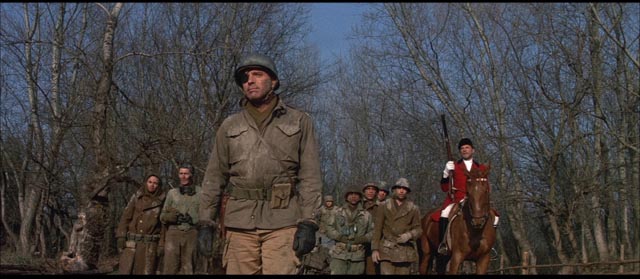
A few weeks back, I mentioned watching Sydney Pollack’s adaptation of Horace McCoy’s devastating Depression-era novel They Shoot Horses, Don’t They? for the first time in years. It holds up very well as a bleak yet colourful exploration of the inextricably intertwined hope and despair at the heart of unfettered Capitalism. Horses was Pollack’s fifth feature. After a half decade of prolific television work, he had launched a theatrical career with The Slender Thread (1965), a well-meaning but thin drama intended to show in human terms that the concept of race is meaningless. The story of an inexperienced crisis-line counselor who struggles to save the life of a woman who has already taken a fatal dose of pills, it makes its point by largely avoiding that point; it posits that race is irrelevant to the connection these two characters forge across the phone line. The would-be suicide is a middle class white woman (Anne Bancroft) and the counselor is a young black man (Sidney Poitier). He saves her life, but they never meet. Race is indeed irrelevant in this particular situation, but its presence would surely gain different implications if their lives were connected in some other way.
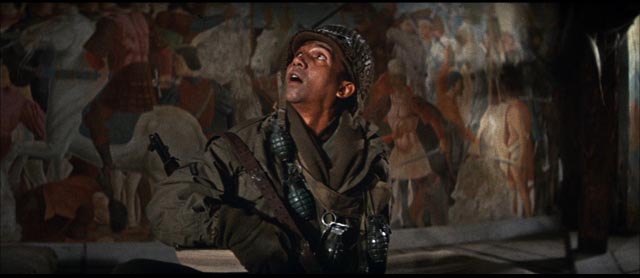
Pollack followed The Slender Thread with a drama based on a Tennessee Williams one-act play (This Property is Condemned, 1966) and then attempted something on a larger scale with a revisionist western starring Burt Lancaster. The Scalphunters (1968) also had a racial theme, with Lancaster’s frontier trapper unwillingly teamed up with Ossie Davis’ well-educated escaped slave. In these first three features, Pollack can be seen exploring various possibilities in terms of material and style. After The Scalphunters, he was hired to “salvage” Frank Perry’s The Swimmer (1968), a literary adaptation which steeped its narrative in metaphor and symbolism. (He was no doubt brought in on the recommendation of that film’s star, Burt Lancaster.)
Although Pollack’s contributions to The Swimmer feel ill-fitting at times (largely due to his California re-shoots not matching the original New England landscapes), it appears that working on this film may have given him a sense of direction, because the three features which followed are – despite radical differences in material – all characterized by strong literary qualities. Pollack doesn’t shy away from foregrounded themes and in fact builds these films visually and dramatically as conscious explorations of those themes – conflicts between the individual and historical forces, the contingency of human relationships, the power of myth to shape and give meaning to arbitrary events.
*
Castle Keep (1969)
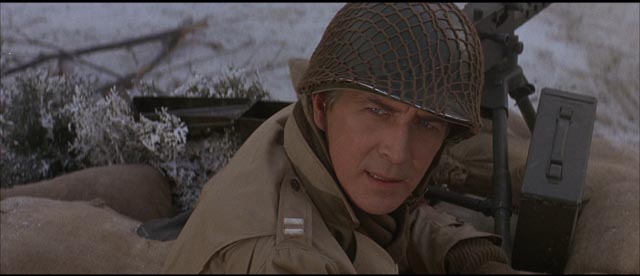
Although I didn’t see it at the time of its original release, and eventually came to it on TV (pan-and-scanned and interrupted by commercials), Pollack’s fourth feature became my favourite among his movies. Castle Keep (1969), based on a novel by William Eastlake, is an unapologetically allegorical war movie – again starring Burt Lancaster – which presents arguments about history, art and civilization through the story of a small American unit which moves into a Medieval castle in the Ardennes on the eve of the Battle of the Bulge. Occupied by a Count (Jean-Pierre Aumont) and his wife Therese (Astrid Heeren), the castle is a repository of European history in the form of a large library and a rich collection of art works.
The unit, in classic movie form, consists of a range of types, providing a varied selection of responses to the central situation which, with the coming German counterattack, threatens the destruction of this embodiment of western civilization. There’s an officer, Beckman (Patrick O’Neal), in civilian life an art historian, who views the preservation of the castle and its contents as more important than the progress of the war. The major in charge, Falconer (Lancaster), points out that if the Germans aren’t stopped, western civilization itself will cease to exist, rendering these artefacts meaningless.
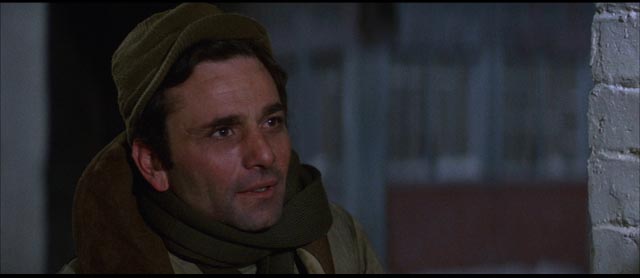
For the foot soldiers, these issues are largely pointless; their concern is with personal survival and immediate gratification. Peter Falk’s baker wants only to make bread, to provide the pleasures of sustenance, and he moves in with the baker’s widow in a nearby village, while his comrades settle for the pleasures offered at the local brothel. Scott Wilson’s corporal falls in love with a Volkswagen, a perfectly engineered machine which for him transcends the national conflicts which caused the war. And observing and commenting on these men and their activities is a young private who aspires to be a writer (Al Freeman Jr) – in fact, self-reflexively, the film itself becomes the record of events which he creates, transforming the war and these men’s experience of boredom, conflict and death into expressions of the themes of boredom, conflict and death.
The most explicit arguments occur between O’Neal’s Captain Beckman and Lancaster’s Major Falconer, who in a pointedly overdetermined detail wears a black patch over one eye; while Beckman sees events in a context of the larger flow of history and the progress of civilization, Falconer’s monocular vision sees only immediate necessity. In effect both men are right and there can be no good ending to the catastrophe which has befallen this civilization, though some may survive to continue on and rebuild (or build something new).
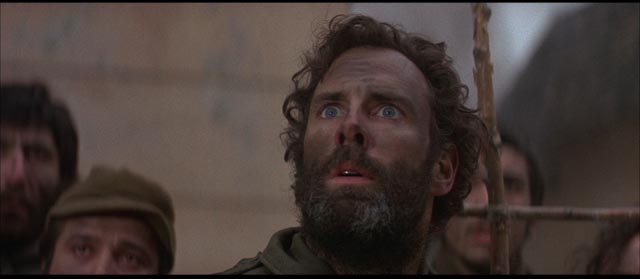
Beckman’s reverence for the artefacts of this civilization is at least partially called into question by what we learn of the Count, the custodian of all this history and art. He is sterile, a historical dead end, and engineers a relationship between Falconer and his young wife, hoping she will become pregnant and produce a child which will continue the family line. European culture is here exhausted, the contents of the castle taking on the air of an epitaph for something already finished, desperate for new blood from a younger but less refined America. In the end, even Beckman has to face the fact that some kind of survival requires the sacrifice of this museum of a dying civilization; at the climax of the final battle, he himself sets off the explosion which stops the Germans by destroying the castle. What survives are the young black writer and the (possibly pregnant) young Countess, promising the birth of something new rather than a continuation of the old, atrophied past.
Pollack directs with great assurance. Gorgeously shot by Henri Decaë (who started his feature career with several films for Jean-Pierre Melville, and went on to shoot a number of key works of the nouvelle vague), the film makes impressive use of its Yugoslav locations; the castle itself is imposing, and the large-scale action set-pieces – the battle in the town and the climactic attack on the castle – show Pollack growing in technical skill. The film has an opulence which gives it a sense of physical scale, which in turn adds weight to its themes. The cast is excellent; as in They Shoot Horses, Don’t They?, Pollack balances the presence of stars with an ensemble which transcends what could have been a collection of stereotypes.
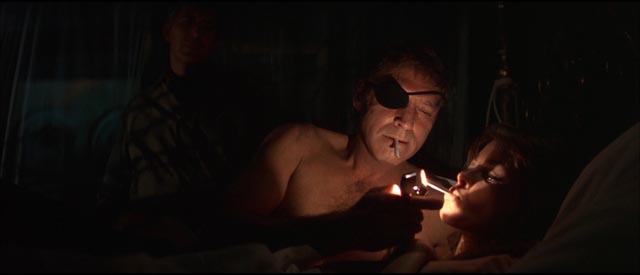
Judging by comments on IMDb, a lot of people dislike Castle Keep specifically because of its allegorical approach to the war film, dismissing it as pretentious. Personally, this is why I like it so much. I see nothing wrong with “pretension” when it’s well-supported by a filmmaker’s artistry. Pollack didn’t set out here to make a realistic war movie about the Battle of the Bulge, and when looked at on its own terms, the film is his first completely successful creative achievement.
I’ve waited years to find a decent copy of this favourite and was delighted to discover a Blu-ray on Amazon UK last Fall. This was my first purchase from a new British company called Indicator, which in its first year has released an impressive slate of titles, most of which in addition to new transfers (the Castle Keep disk has a superb image) include multiple supplements – this disk has a 100-minute audio interview with Lancaster, a new 18-minute interview with actor Tony Bill about working on the film, a 29-minute archival interview with author William Eastlake, plus a thick booklet containing new and archival material. In terms of quality and range, Indicator appears to be in line to join Arrow, the BFI and Criterion as one of the best sources for significant, high-quality disk releases.
*
Jeremiah Johnson (1972)
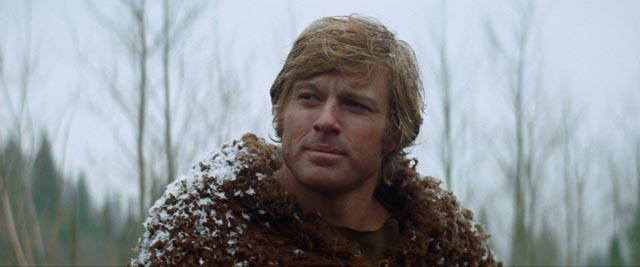
They Shoot Horses, Don’t They? was released just four-and-half months later. While the film paid close attention to the physical details of the grueling dance marathon entered by its hopeless characters, it leans on the metaphorical quality of McCoy’s story. These people are both lured and trapped by the American dream of material success, but that dream is an illusion and they’re all doomed to be crushed by disappointment and brutal failure.
Despite five Oscar wins and four more nominations (including one for direction), three years passed before Pollack released another feature. In Jeremiah Johnson (1972), he tackled another American myth, the more primal (pre-Capitalist) one of the individual against a harsh and unforgiving nature in the Western wilderness. Based on a novel by Vardis Fisher and a non-fiction account by Raymond W. Thorp and Robert Bunker, the film declares itself as myth rather than history in its opening moments. Jeremiah arrives by river in a remote town overshadowed by mountains as a narrator tells us that no one knew who he was or where he came from, just that he was intent on heading into the wilderness to live alone as a trapper.
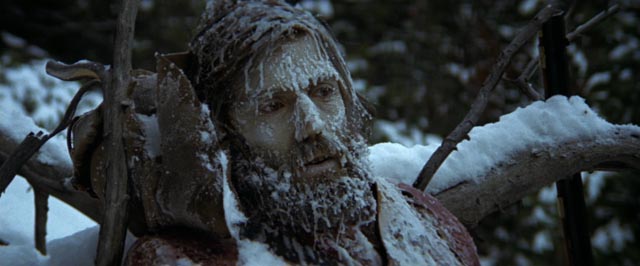
Although the script (combining the contradictory talents of Edward Anhalt – an old Hollywood hand whose work ranged from noir and westerns to prestige adaptations – and the ultra-macho John Milius) gives us no more information about Jeremiah, the fact that he arrives wearing a faded military uniform suggests a particular reason for his flight from human society. The irony which gradually emerges is that, no matter how far he travels, it’s ultimately impossible to escape the violence inherent in human nature. The difference is that, having fled society’s wars, he becomes embroiled in a more personal conflict.
The film is a picaresque, an episodic string of incidents through which the character grows and evolves; this is the quintessential Robert Redford performance, made up of silences and probing looks, an alert stillness which suggests a powerful intelligence behind an outward passivity. At first he knows little about survival, almost freezing and starving in the high mountain winter. His first encounter is with another mountain man who has frozen to death after breaking both legs in a fight with a bear; his second encounter is with a lone Indian, later identified as Paints His Shirt Red (Joaquin Martinez), who witnesses his pathetic attempts to grab fish from an icy stream with his bare hands; his third with a crusty old man who has managed to make a life for himself in the wilderness hunting grizzlies. This man, Bear Claw (Will Geer), becomes a kind of mentor; after saving Jeremiah, he teaches him a few lessons on how to make his way in this inhospitable environment.
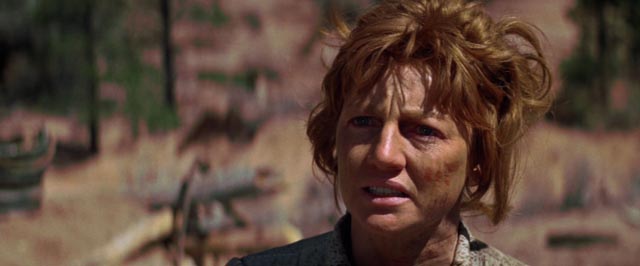
There are other encounters – a settler woman (Allyn Ann McLerie) whose family has been slaughtered by an Indian raiding party, and her now mute young son Caleb (Josh Albee), whom she pleads with Jeremiah to take away so she can be alone with her madness and grief; a bragging trapper and scalp-hunter named Del Gue (Stefan Gierasch), left by a raiding party buried to his neck in sand; a bilingual Chief, Two-Tongues Lebeaux (Richard Algarola), who because of a series of misunderstandings caused by Jeremiah’s ignorance of tribal etiquette, ends up giving the mountain man his own daughter, Swan (Delle Bolton), as a wife. Jeremiah, despite his desire to be alone in the wilderness, now finds himself with a pieced together family. It’s as if nature itself insists on some form of human community.
Although this family starts out with resentment and distrust, it grows closer and warmer. They settle by a river, build a log cabin, find time to play in between the hard tasks of survival. But this idyll can’t last, and one day a column of soldiers arrive seeking Jeremiah’s services as a guide to lead them up into a mountain pass where a party of settlers is trapped in the snow, doomed to die unless rescued. Their arrival brings a sense of menace which in retrospect highlights the fact that Jeremiah has already actually found what he was looking for by coming to this wilderness. These men are a threat to him and his family, a threat which is fulfilled not by direct action, but rather by drawing Jeremiah back into that other world.
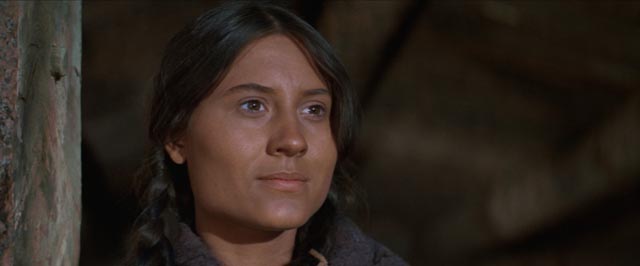
He reluctantly agrees to guide them, but they reject crucial aspects of the knowledge he’s gained; when he tells them they have to take a long detour to avoid violating a sacred Crow burial ground, these men – their officer (Jack Colvin) and the arrogant minister (Paul Benedict) who rides with them – reject native superstition and insist on going ahead. Jeremiah leads them through and they find the desperate settlers. Returning alone through the burial ground, Jeremiah senses something terrible and rides hard back to the cabin where he finds Swan and Caleb killed in retribution.
This tragedy causes the narrative to break down completely and the final stretch of the film becomes a hallucinatory montage of aimless violence as the man who initially attempted to escape his own violent society becomes the killing spirit of that society decimating the native population in a murderous desire to obliterate the Other. Although the film ends inconclusively in a seeming moment of truce in which Jeremiah and Paints His Shirt Red salute each other across a snowy expanse, history tells us that this brutal conflict will continue. Jeremiah, receding into myth, has become an indelible representation of the thing he once tried to escape.
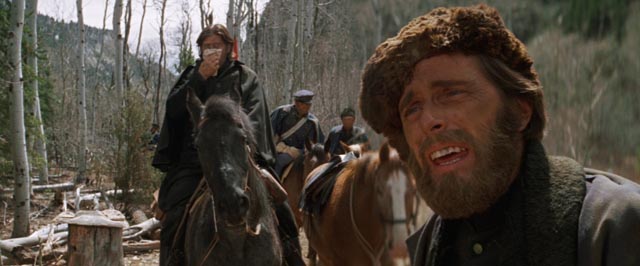
Jeremiah Johnson is a very visceral film, the impressive photography of Duke Callaghan giving physical power to the harsh Utah landscapes and brutally cold weather. Perhaps because of the conflicting sensibilities of the two writers, there is an unresolved tension between its elevation of the mountain man to the level of myth and the darker historical currents of genocidal violence inflicted on the native population as an integral part of westward expansion. At first there is a temptation to see Jeremiah’s rejection of white society as noble, a desire to return to existence at its most basic level; this idealization of the rugged individualist is in line with Milius’ other work (frontiersman as barbarian hero). But the film has the honesty to problematize this portrait, even if it never quite disavows it. There is nostalgia for the idea, but also a recognition of its incompleteness. The cost of Jeremiah’s independence is death and destruction for others.
The film looks quite spectacular on the Warner Blu-ray, but the disk has one peculiarity. Although the film runs less than two hours, it stops suddenly around the 80-minute mark for an intermission. I certainly don’t recall this from when I saw the movie in a theatre in 1973 (the first movie I ever saw at Winnipeg’s late lamented Cinema 3). It’s an odd roadshow affectation which seems out of place on this disk.
Jeremiah Johnson would make an interesting double-bill with Robert Altman’s McCabe & Mrs. Miller (1971), which expands on some of its themes, but at a later point in the progress of Manifest Destiny as it consumed the West.
*
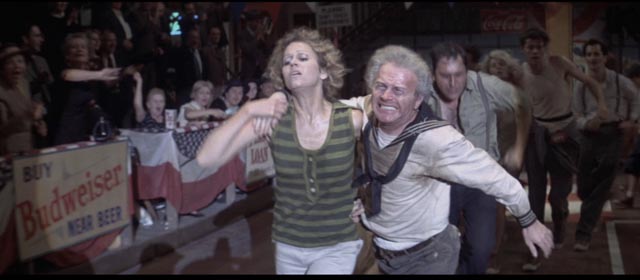
After this half decade of interesting projects through which Sydney Pollack developed as a filmmaker, something happened and I’m not sure what that was. He followed Jeremiah Johnson with The Way We Were (1973), a glossy soap opera romance which touched tangentially on Hollywood’s darker history, with references to the anti-Communist witch hunt of the ’40s and subsequent blacklist. But with its emphasis on its stars (Redford again, and Barbra Streisand) and their romance, it lacked the clarity of the earlier films’ sense of period. Following this, much of Pollack’s work has been star-oriented and firmly rooted in Hollywood’s tradition of prestige middlebrow entertainment.
The Yakuza (1974), although it introduced Japanese gangsters to a North American audience, presented a romanticized image of its subject which was already being torn apart by the brutal realism of native filmmakers like Kinji Fukasaku. Three Days of the Condor was a polished but routine paranoid thriller into which was inserted a tangential romance, while movies like Bobby Deerfield, Out of Africa and Havana are bloated and inauthentic romances. Which is not to say that Pollack hasn’t had a commercially successful career, garnering numerous awards along the way … just that he seems to have exhausted his creativity in those early years, with the three features he made between 1969 and 1972 comprising his best work.
Comments
They Shoot Horses a favorite. Will see Castle Keep and Jeremiah Johnson.Thanks.